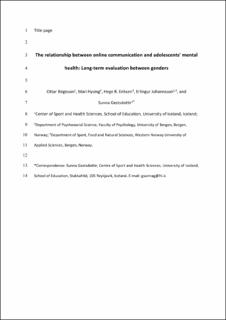| dc.description.abstract | Aims: In a relatively short time, online communication has become an important part of adolescents’ lives, and concerns have been raised about its potential effects on mental health. The first aim was to compare mental health status and online communication in 15-year-old Icelanders born in 1988 and in 1994. The second aim was to assess whether the relationship between online communication and mental health has changed among 15-year-old Icelanders from 2003 to 2015 across genders. Methods: Analysis used data from self-reports from 2003 (N=385, 51% males) and 2015 (N=302, 42% males). Mental health was assessed with subscales of Symptom Checklist 90 and online communications with self-reports. To evaluate the difference in anxiety and depression, a factorial analysis of variance was conducted between gender and years. Multigroup structural equation modelling was used to assess the change in the relationship between years. Results: Symptoms of anxiety and depression remained unchanged for males. Symptoms of depression increased for females, while anxiety was stable between 2003 and 2015. In 2003, there was no relationship between online communication and mental health. However, in 2015, an association was found for females. Conclusions: Depression is getting worse for adolescent females, and an association between time spent online communicating and mental health emerged for them in 2015, which did not exist in 2003. These findings add to the possibility that online communication is harmful for mental health, but more detailed studies are still needed. | en_US |
